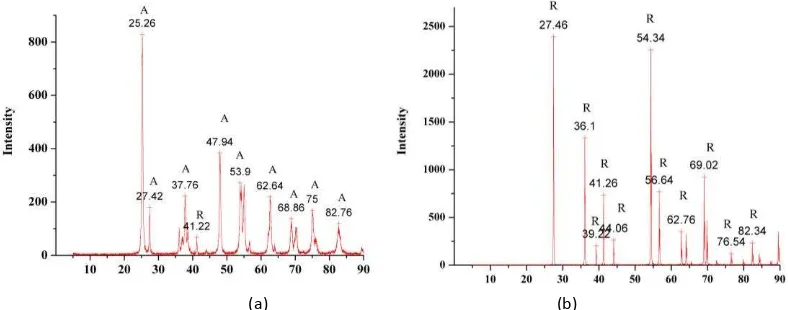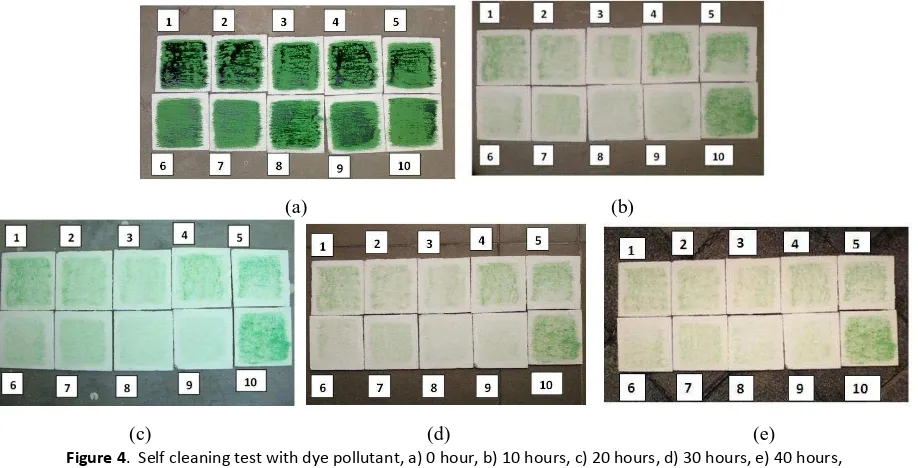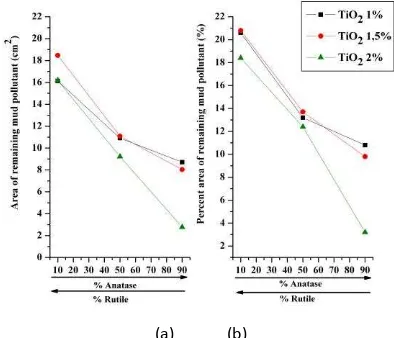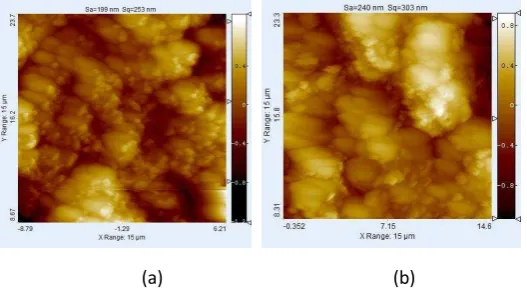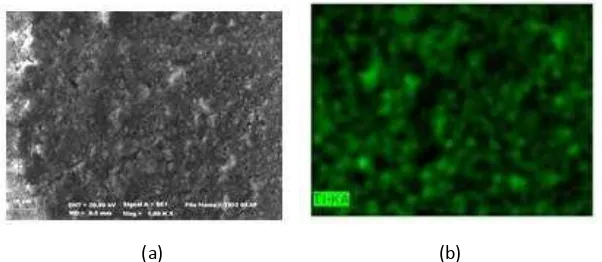Application of TiO
2
for Self Cleaning in Water Based
Paint with Polyethylene Glycol (PEG) as Dispersant
Nining Kusmahetiningsiha, Dyah Sawitrib
Departement of Engineering Physics, Faculty of Industrial Engineering, Sepuluh Nopember Institute of Technology, Kampus ITS Keputih-Sukolilo Surabaya 60111INDONESIA TiO2distribution. Image J was used to calculate area of pollutant and distribution of TiO2. The results show that 2% TiO2 with ratio of anatase
: rutile 90:10 has the minimum pollutant area indicating the best self cleaning properties. FTIR characterizations show absorbance peak at 1080 cm-1 wave numbers indicating characteristic peaks of PEG. The increase of peaks at around that wave number indicates maximum TiO
2
aggregation. It was found that 2% TiO2 with ratio of anatase : rutile 90:10 has the minimum peak at that particular wave number. The AFM
image for this composition shows that aggregate distribution of TiO2 in the film paints are more homogenous compare with other samples
leading to an improved self cleaning properties.
Keywords: anatase. PEG, rutile, self cleaning, TiO2
1. Introduction
Paint is mostly used to cover a surface of building as decorative. Environmental pollution like dust, mud, and bacteria could make the surface become dirty. Therefore, paint with self cleaning properties is required to solve those problems.
TiO2 has been known for its photocatalyst and also hydrophilic properties, which provide self cleaning
coating. A self-cleaning coating of photocatalytic TiO2 is used for photodegradation of organic compounds into CO2
and H2O with UV irradiation. Hydrophilic surface allows dirt or stain to be easily washed away with water. But,
photocatalytic activity in paint comprising organic binder is considered undesirable [1]. Photocatalytic activity can oxidize the organic binder which may result in flaking of the paint film [2]. TiO2 anatase and rutile were used in this
research to give self cleaning properties in paint without causing the film to flake too fast. Anatase crystal was used as photocatalytic effect for self cleaning application and rutile crystal was used as an UV stabilizing to protect the organic binder [1].
TiO2 catalyst is generally in the powder form, so it tends to aggregate in suspension and decrease its
photocatalytic activity. Recently, previous studies investigated polyethylene glycol (PEG) was used to stabilize nano-TiO2 in aqueous suspension [3]. In this research, PEG will be added to reduce the aggregation of TiO2 in paint,
in such a way it can improve photocatalytic activity and hydrophilic properties of catalyst that could work in self cleaning application.
2. Material and Methods
Nano-TiO2 used in this research was Degussa P25 consisting of anatase and rutile crystal. The PEG with
average relative molecular mass of 6000, distillated water, and white water based paint were used in the experiments. Table 1 shows the composition of TiO2 and the ratio of anatase : rutile.
The first step of preparation was making a suspension of TiO2 and distillated water with composition anatase
: rutile based on table 1. Then, the suspe sio was i ed usi g ag eti stirrer for hours at ⁰C. After that PEG 6000 with mass four times of TiO2 catalyst weight was added. Finally the suspension was mixed again using
software ImageJ (from National Institute of Health (NIH), USA) was used to characterize self cleaning properties of each sample.
3. Result and Discussion.
The results of XRD characterization are shown in Figure 1. From Figure 1 (a), it could be known that almost all of the crystal type is anatase (marked with A). Peaks of TiO2a atase are show at Θ = . ; . ; ,9 ; ,9 ;
a d , . Figure shows peaks at Θ = , ; , ; , ; , ; a d , that indicate the rutile crystalline phase of TiO2 (marked with R).
(a) (b)
Figure. 1. XRD result of nano-TiO2 Degussa P25 a) anatase, b) rutile
Figure 2 illustrates the FTIR characterization of suspension nano-TiO2/ PEG 6000. Figure 3, there are peaks at
3000-3500 cm-1 wave numbers indicates hydroxyl (OH-) and 1600 cm-1 wave numbers indicating H-O-H bond. On the other hand, peaks at around 1080 cm-1 wave numbers indicates the characteristic peaks of PEG were found in all samples [3].
Table1. Concentration of TiO2
No. TiO2 (%) Anatase : Rutile
1 1 10 : 90
2 1 50 : 50
3 1 90 : 10
4 1.5 10 : 90
5 1.5 50 : 50
6 1.5 90 : 10
7 2 10 : 90
8 2 50 : 50
9 2 90 : 10
Figure 2. FTIR spectra of suspension nano-TiO2/PEG 6000 with ratio anatase : rutile 10:90, a) TiO2 1%, b) TiO2 1.5%, c) TiO2 2%
The results of self cleaning test with mud pollutant are shown in Figure 3.
(a) (b)
(c) (d) (e)
Figure 3. Self cleaning test with mud pollutant, a) 0 hour, b) 10 hours, c) 20 hours, d) 30 hours , e) 40 hours ; number 1 to 10 indicate sample condition as listed in Table 1
(a) (b)
(a) (b)
Figure 5. The influence of UV radiation time to pollutant degradation, a) mud pollutant, b) dye pollutant
From Figure 5 it can be seen that area of pollutant decreases by adding UV radiation time. This results show that the longer radiation process in the surface of TiO2, the more photon energy was absorbed [4]. It means that
the more radical hydroxyl and hole interacted with pollutant at the surface [4]. Photocatalyst activity to pollutant degradation reaches optimum condition when UV radiation for 40 hours. It could degrade 96.8% and 98.5% for mud and dye pollutants, respectively.
(a) (b)
Figure 6. Results of image processing for self cleaning test with mud pollutant for 40 hours UV radiation, a) Area of remaining mud pollutant, b) Percent area of remaining mud pollutant
Figure 6 and Figure 7 shows that TiO2 2 % with ratio of anatase : rutile 90 :10 has the minimum area and
percent area of remaining pollutant. It means that this composition, TiO2 catalyst can perform self cleaning
Figure 7. Results of image processing for self cleaning test with mud pollutant for 40 hours UV radiation, a) Area of remaining mud pollutant, b) Percent area of remaining mud pollutant
The surface morphology of TiO2 1% with ratio anatase : rutile 50 : 50 and TiO2 2% with ratio anatase: rutile
90 :10 are taken using AFM in phase imaging mode and shown in Figure 8.
(a) (b)
Figure 8. AFM image a) TiO2 1% with ratio anatase : rutile 50:50, b) TiO2 2% with ratio anatase : rutile 90:10
As shown in Figure 8, the surface morphology reveals the nano-crystalline TiO2 grains [5]. Area, average size,
and percent area of TiO2 is summarized in Table 2. From the data, it is found that the TiO2 grains at composition
TiO2 2% with ratio anatase: rutile 90 :10 has smaller size compare to other samples.
Table 2. The results of image processing for AFM test
No. TiO2 (%) Anatase : Rutile
Area of TiO2
(cm2) Average Size (cm 2
) Percent Area of TiO2 (cm2)
1 1 50:50 117.19 0.215 52.2
2 2 90:10 120.68 0.112 53.8
In order to corroborate the AFM results, the samples have been investigated by SEM. The dispersion of TiO2
in sample containing TiO2 2% with ratio anatase: rutile 90 : 10 was studied using SEM-EDX. The secondary electron
images as well as the respective EDX results are shown in Figure 9. It is clear that TiO2 particles are dispersed
homogenously throughout the sample. Such distribution is advantageous in enhancing the self cleaning properties. These results are in agreement with earlier findings that the decreasing of TiO2 aggregates in samples containing
adequate PEG is caused by PEG ability to form surface barrier thereby the Ti particles agglomeration are reduced
(a) (b)
Figure 9. SEM Image of TiO2 2% with ratio anatase : rutile 90:10, a) SEM image, b) EDX image
4. Conclusion
The application of TiO2 in water based paint with PEG dispersant has been done studied and some
conclusions can be drawn as follows:
1. Nano- TiO2 applied to water based paint, results in paint self cleaning properties.
2. Best self cleaning properties were obtained for 40 hours radiation time sample containing TiO2 2% with
ratio anatase: rutile 90:10 with 96.8% mud pollutant and 98.5% dye pollutant being degraded.
Acknowledgement
The author would like to thank to Directorate General of Higher Education for funding this research through student creativity program 2012
References
[1] Burgess K.D. Self Cleaning Titania-Polyurethane Composites. 2007. Faculty of Graduates Studies, The University of Western Ontario, London.
[2] Hillebrandt Poulsen, et al. 2010. Self Cleaning Coating Composition. International Application Published under The Patent
Cooperation Treaty. PCT WO 2010/269997 A1.
[3] PENG Bing, et al. 2007. Influence of polymer dispersants on dispersion stability of nano-TiO2 aqueous suspension and its
application in inner wall latex paint. J. Cent. South Univ. Technol. − 9 − DOI : . /s -007-0095-z pages : 491-495.
[4] Aprilita N.H. 2007. Preparation of Self-Cleaning Glass Based on TiO2 Films for Photodegradation of Palmitic Acid.
International Conference on Chemical Sciences (ICCS) pages : 1-5.
[5] Hasan M.M, et al. 2008. Effects of Annealing Treatment on Optical Properties of Anatase TiO2 Thin Films. International
Journal of Chemical and Biological Engineering 1:2 pages : 92-95.
[6] Tristantini et al. 2011. Modification of TiO2 Nanoparticle with PEG and SiO2 for Anti-fogging and Self-cleaning Application.
